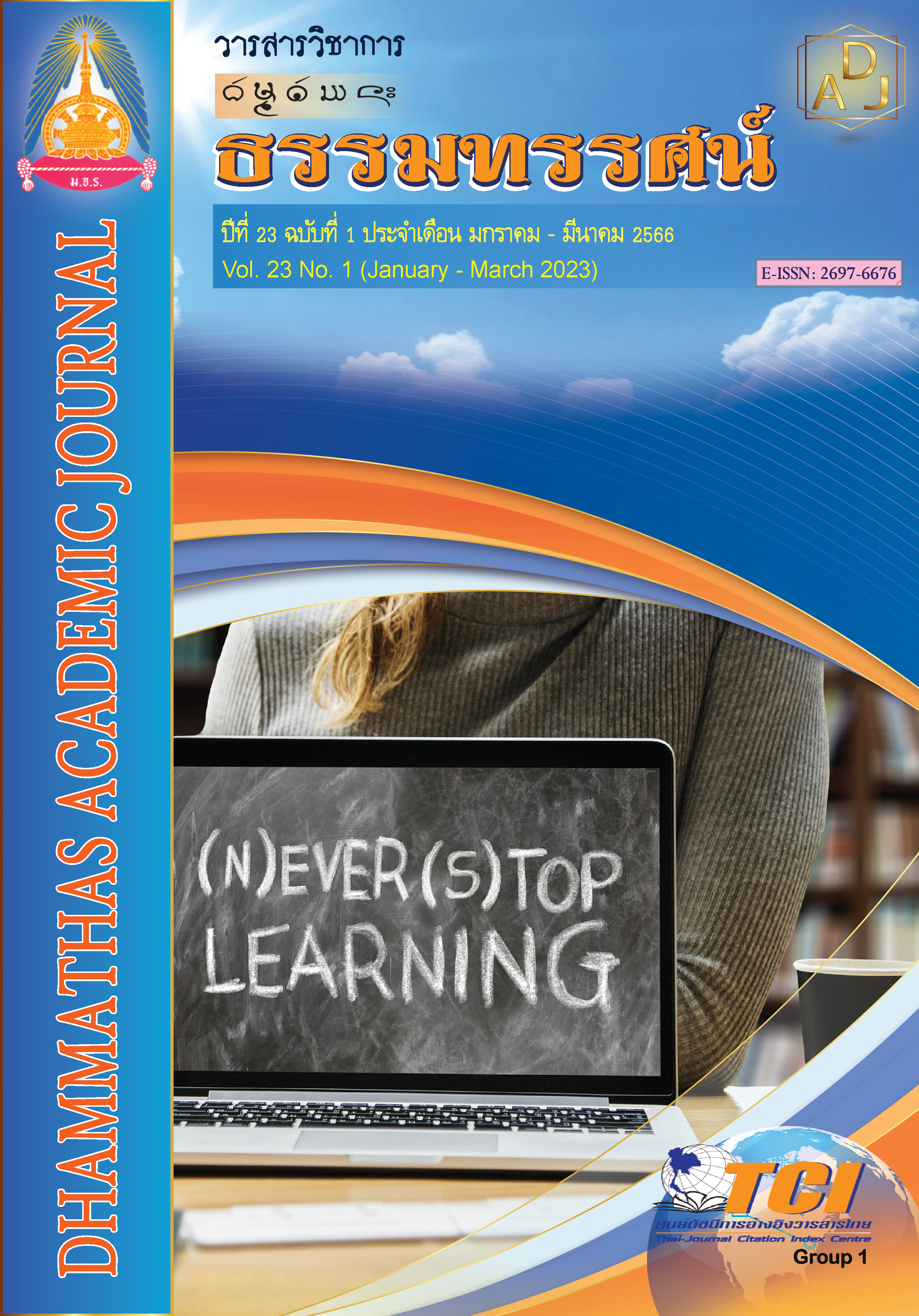Developing an Innovation to Promote Multicultural Society Learning in the New Normal for Ethnic Students in Vocational Institutes, Chiang Mai Province
Main Article Content
Abstract
The objectives of this research were 1) to study necessity and expectations about multicultural society learning in the new normal for ethnic students in vocational institutes, Chiang Mai Province, and 2) to create innovation to promote multicultural society learning in the new normal for ethnic students in vocational institutes, Chiang Mai Province, The sample consisted 1st year vocational certificate students studying at a public vocational school with a location in Chiang Mai Province who were studying in the first semester of the academic year 2022, 345 students. The research instruments were composed of this questionnaire and assessment form. The data were analyzed by mean, standard deviation and percentage.
Study findings were as follows:
1. The results of a study on the necessity and expectations of multicultural education management for ethnic students who were studying in vocational institutes, Chiang Mai Province, found that 1) the aim of the study Students wanted to study multicultural society for equality and diversity of cultures. 2) Time structure Students wanted to study multicultural society in 1-3 hours, 3) on the content of multicultural society. Learners wanted to learn about the diversity of races and ethnicities. 4) The learning style of learning multicultural society in a new normal way Learners wanted to learn in an online format, 5) in terms of measurement and evaluation. Learners wanted to measure and evaluate with a self-assessment form.
2. Innovation to Promote Multicultural Society Learning in the New Normal for Ethnic students in vocational institutes, Chiang Mai Province, online lessons on Multicultural Society in Chiang Mai (https://muti-ed.com/) was of good quality in all aspects accounted for 87.40 percent.
Article Details

This work is licensed under a Creative Commons Attribution-NonCommercial-NoDerivatives 4.0 International License.
เพื่อให้เป็นไปตามกฎหมายลิขสิทธิ์ ผู้นิพนธ์ทุกท่านต้องลงลายมือชื่อในแบบฟอร์มใบมอบลิขสิทธิ์บทความ ให้แก่วารสารฯ พร้อมกับบทความต้นฉบับที่ได้แก้ไขครั้งสุดท้าย นอกจากนี้ ผู้นิพนธ์ทุกท่านต้องยืนยันว่าบทความ ต้นฉบับที่ส่งมาตีพิมพ์นั้น ได้ส่งมาตีพิมพ์เฉพาะในวารสาร วิชาการธรรม ทรรศน์ เพียงแห่งเดียวเท่านั้น หากมีการใช้ ภาพหรือตารางของผู้นิพนธ์อื่นที่ปรากฏในสิ่งตีพิมพ์อื่นมาแล้ว ผู้นิพนธ์ต้องขออนุญาตเจ้าของลิขสิทธิ์ก่อน พร้อมทั้ง แสดงหนังสือที่ได้รับการยินยอมต่อบรรณาธิการ ก่อนที่บทความจะได้รับการตีพิมพ์References
กาญจนา บุญภักดิ์. (2563). การจัดการเรียนรู้ยุค New Normal. วารสารครุศาสตร์อุตสาหกรรม, 19(2), 346-356.
จุไรพร จิตพิทักษ์. (2553). ชีวิตวัยรุ่นปกาเกอะญอในสังคมสมัยใหม่. เข้าถึงได้จาก https://cmudc.library.cmu.ac.th/frontend/Info/item/dc:49852
ชรินทร์ มั่งคั่ง. (2560). อุดมคติวิทยา หลักสูตรสังคมศึกษาเพื่อปวงชน. กรุงเทพฯ: จุฬาลงกรณ์มหาวิทยาลัย.
เชษฐภูมิ วรรณไพศาล. (2558). การพัฒนารูปแบบการจัดการศึกษาตามแนวทางพหุวัฒนธรรมศึกษาสำหรับนิสิตนักศึกษากลุ่มชาติพันธุ์ในสถาบันอุดมศึกษาภาคเหนือ. (วิทยานิพนธ์ครุศาสตรดุษฎีบัณฑิต). กรุงเทพฯ: จุฬาลงกรณ์มหาวิทยาลัย.
ทิศนา แขมมณี. (2545). ศาสตร์การสอน. กรุงเทพฯ: จุฬาลงกรณ์มหาวิทยาลัย.
ธนะวัฒน์ วรรณประภา. (2560). สื่อสังคมออนไลน์กับการศึกษา. วารสารศึกษาศาสตร์ มหาวิทยาลัยมหาสารคาม, 11(1), 7-20.
นิตยา มณีวงศ์. (2564). ศึกษาพฤติกรรมและปัจจัยความสำเร็จในการเรียนออนไลน์. ครุศาสตร์สาร, 15(1), 161-173.
พระมหามงคลกานต์ ฐิตธมฺโม และอาภรณ์รัตน์ เลิศไผ่รอด. (2563). การอยู่ร่วมกันของคนในสังคมพหุวัฒนธรรมในประเทศไทย กรณีศึกษา สังคมพหุวัฒนธรรมในอำเภอเมือง จังหวัดเชียงใหม่. วารสาร มจร อุบลปริทรรศน์, 5(3), 316-324.
พัชราภรณ์ ดวงชื่น. (2563). การบริหารจัดการศึกษารับความปกติใหม่หลังวิกฤตโควิด-19. วารสารศิลปการจัดการ, 4(3), 783-795.
ภูมิศรัณย์ ทองเลี่ยมนาค. (2564). ความปกติใหม่ทางการศึกษากับความเหลื่อมล้ำที่มากยิ่งขึ้น. วารสารวิชาการรัตนบุศย์, 3(2), 69-83.
วิทยา วาโย. (2563). การเรียนการสอนแบบออนไลน์ภายใต้สถานการณ์แพร่ระบาดของไวรัส COVID-19: แนวคิดและการประยุกต์ใช้จัดการเรียนการสอน. วารสารศูนย์อนามัยที่ 9, 14(34), 285-298.
Yamane, T. (1973). Statistics: An Introductory Analysis. (3rd Ed). New York: Harper and Row Publications.

